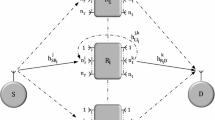Abstract
In this paper, we investigate the end-to-end average signal-to-noise ratio (SNR) of dual-hop amplify-and-forward wireless communication systems operating over independent but not necessarily identically distributed (i.n.i.d.) \(\eta {-}\mu \) fading channels. Specifically, we derive a novel exact closed-form expression for the generalized end-to-end average SNR for arbitrary fading parameters \(\eta \) and \(\mu \). Using the obtained closed-form expression for the generalized end-to-end average SNR, some important performance metrics such as the average end-to-end SNR, the amount of fading and the channel capacity can be easily obtained. The effect of the fading parameters and the power imbalance on the overall system performance is investigated. The analytical results are validated by means of Monte-Carlo simulations.









Similar content being viewed by others
References
Hasna, M. O., & Alouini, M. (2004). A performance study of dual-hop transmissions with fixed gain relays. IEEE Transactions on Wireless Communications, 3(6), 1963–1968.
Ikki, S. S., & Ahmed, M. H. (2009). Exact error probability and channel capacity of the best-relay cooperative-diversity networks. IEEE Signal Processing Letters, 16(12), 1051–1054.
Al-Qahtani, F. S., Duong, T. Q., Zhong, C., Qaraqe, K. A., & Alnuweiri, H. M. (2011). Performance analysis of dual-hop AF systems with interference in nakagami-m fading channels. IEEE Signal Processing Letters, 18(8), 454–457.
Ikki, S. S., & Aïssa, S. (2012). Performance evaluation and optimization of dual-hop communication over nakagami-m fading channels in the presence of co-channel interferences. IEEE Communications Letters, 16(8), 1149–1152.
Soliman, S. S., & Beaulieu, N. C. (2012). Exact analysis of dual-hop AF maximum end-to-end SNR relay selection. IEEE Transactions on Communications, 60(8), 2135–2145.
Badarneh, O. S., Kadoch, M. (2012). Performance analysis of dual-hop systems with fixed-gain relays over generalized \(\eta {-}\mu \) fading channels, In 2012 IEEE global communications conference, GLOBECOM 2012, Anaheim, December 3–7, 2012 (pp. 4148–4152).
Zhong, C., Matthaiou, M., Karagiannidis, G. K., & Ratnarajah, T. (2011). Generic ergodic capacity bounds for fixed-gain AF dual-hop relaying systems. IEEE Transactions on Vehicular Technology, 60(8), 3814–3824.
Yacoub, M. D. (2007). The \(\kappa {-}\mu \) distribution and the \(\eta {-}\mu \) distribution. IEEE Antennas and Propagation Magazine, 49(1), 68–81.
Prudnikov, A. P., Brychkov, Y. A., & Marichev, O. I. (1990). Integrals, and series: More special Functions. New York: plus Gordon and Breach Science and Publications.
Papazafeiropoulos, A. K., & Kotsopoulos, S. A. (2011). The \(\alpha {-}\lambda {-}\mu \) and \(\alpha {-}\eta {-}\mu \) small-scale general fading distributions: A unified approach. Wireless Personal Communications, 57, 735–751.
Papazafeiropoulos, A.K., Kotsopoulos, S. A., Zevgolis, D. (2009). “The \(\alpha {-}\lambda {-}\mu {-}\eta \): a general fading distribution,” In 2009 IEEE wireless communications and networking conference, WCNC 2009, proceedings, Budapest, Hungary, April 5–8, 2009 (pp. 404–409).
Prudnikov, A. P., Brychkov, Y. A., & Marichev, O. I. (1992). Integrals, and series: Direct laplace transforms (Vol. 4). New York: Gordon and Breach Science Publishers.
Mathai, A., & Saxena, R. (1978). The H-function with applications in statistics and other disciplines. New York: Iley Eastern, New Delhi, and Halsted Press.
Peppas, K. P. (2012). A new formula for the average bit error probability of dual-hop amplify-and-forward relaying systems over generalized shadowed fading channels. IEEE Wireless Communications Letters, 1(2), 85–88.
Ansari, I. S., Al-Ahmadi, S., Yilmaz, F., Alouini, M., & Yanikomeroglu, H. (2011). A new formula for the BER of binary modulations with dual-branch selection over generalized-k. IEEE Transactions on Communications, 59(10), 2654–2658.
Win, M. Z., Mallik, R. K., & Chrisikos, G. (2003). Higher order statistics of antenna subset diversity. IEEE Transactions on Wireless Communications, 2(5), 871–875.
Pérez, J., Ibá nez, J., Vielva, L., & Santamaría, I. (2005). Closed-form approximation for the outage capacity of orthogonal STBC. IEEE Communications Letters, 9(11), 961–963.
Author information
Authors and Affiliations
Corresponding author
Rights and permissions
About this article
Cite this article
Badarneh, O.S. Exact Closed-Form Expression for End-to-End Average SNR of Dual-Hop Amplify-and-Forward in Wireless Relaying Systems. Wireless Pers Commun 86, 1023–1036 (2016). https://doi.org/10.1007/s11277-015-2970-5
Published:
Issue Date:
DOI: https://doi.org/10.1007/s11277-015-2970-5




